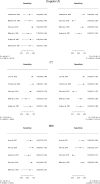Diagnostic accuracy of Doppler ultrasound, CT and MRI in Budd Chiari syndrome: systematic review and meta-analysis
- PMID: 32150462
- PMCID: PMC7217562
- DOI: 10.1259/bjr.20190847
Diagnostic accuracy of Doppler ultrasound, CT and MRI in Budd Chiari syndrome: systematic review and meta-analysis
Abstract
Objective: To evaluate the sensitivity, specificity, and diagnostic odds ratio (DOR) of Doppler ultrasound, CT, and MRI in the diagnosis of Budd Chiari syndrome (BCS).
Methods: We performed a literature search in PubMed, Embase, and Scopus to identify articles reporting the diagnostic accuracy of Doppler ultrasound, CT, and MRI (either alone or in combination) for BCS using catheter venography or surgery as the reference standard. The quality of the included articles was assessed by using the Quality Assessment of Diagnostic Accuracy Studies-2 tool.
Results: 11 studies were found eligible for inclusion. Pooled sensitivities and specificities of Doppler ultrasound were 89% [95% confidence interval (CI), 81-94%, I2 = 24.7%] and 68% (95% CI, 3-99%, I2 = 95.2%), respectively. Regarding CT, the pooled sensitivities and specificities were 89% (95% CI, 77-95%, I2 = 78.6%) and 72% (95% CI, 21-96%, I2 = 91.4%), respectively. The pooled sensitivities and specificities of MRI were 93% (95% CI, 89-96%, I2 = 10.6%) and 55% (95% CI, 5-96%, I2 = 87.6%), respectively. The pooled DOR for Doppler ultrasound, CT, and MRI were 10.19 (95% CI: 1.5, 69.2), 14.57 (95% CI: 1.13, 187.37), and 20.42 (95% CI: 1.78, 234.65), respectively. The higher DOR of MRI than that of Doppler ultrasound and CT shows the better discriminatory power. The area under the curve for MRI was 90.8% compared with 88.4% for CT and 86.6% for Doppler ultrasound.
Conclusion: Doppler ultrasound, CT and MRI had high overall diagnostic accuracy for diagnosis of BCS, but substantial heterogeneity was found. Prospective studies are needed to investigate diagnostic performance of these imaging modalities.
Advances in knowledge: MRI and CT have the highest meta-analytic sensitivity and specificity, respectively for the diagnosis of BCS. Also, MRI has the highest area under curve for the diagnosis of BCS.
Figures
Similar articles
-
Acute Appendicitis: A Meta-Analysis of the Diagnostic Accuracy of US, CT, and MRI as Second-Line Imaging Tests after an Initial US.Radiology. 2018 Sep;288(3):717-727. doi: 10.1148/radiol.2018180318. Epub 2018 Jun 19. Radiology. 2018. PMID: 29916776
-
Diagnostic accuracy of magnetic resonance angiography for Budd-Chiari syndrome: A meta-analysis.Exp Ther Med. 2018 Dec;16(6):4873-4878. doi: 10.3892/etm.2018.6764. Epub 2018 Sep 19. Exp Ther Med. 2018. PMID: 30542443 Free PMC article.
-
Contrast-Enhanced Ultrasound is a Useful Adjunct to Doppler Ultrasound in the Initial Assessment of Patients Suspected of Budd Chiari Syndrome.Curr Probl Diagn Radiol. 2021 Sep-Oct;50(5):646-649. doi: 10.1067/j.cpradiol.2020.07.004. Epub 2020 Jul 25. Curr Probl Diagn Radiol. 2021. PMID: 32807544
-
Diagnostic performance of CT, gadoxetate disodium-enhanced MRI, and PET/CT for the diagnosis of colorectal liver metastasis: Systematic review and meta-analysis.J Magn Reson Imaging. 2018 May;47(5):1237-1250. doi: 10.1002/jmri.25852. Epub 2017 Sep 13. J Magn Reson Imaging. 2018. PMID: 28901685
-
Accuracy of imaging modalities for adnexal torsion: a systematic review and meta-analysis.BJOG. 2021 Jan;128(1):37-44. doi: 10.1111/1471-0528.16371. Epub 2020 Jul 23. BJOG. 2021. PMID: 32570294
Cited by
-
A deep-learning pipeline to diagnose pediatric intussusception and assess severity during ultrasound scanning: a multicenter retrospective-prospective study.NPJ Digit Med. 2023 Sep 30;6(1):182. doi: 10.1038/s41746-023-00930-8. NPJ Digit Med. 2023. PMID: 37775624 Free PMC article.
-
Budd-Chiari syndrome (BCS): a challenging diagnosis not to be overlooked-single center report and pictorial essay.J Ultrasound. 2023 Mar;26(1):249-254. doi: 10.1007/s40477-022-00723-x. Epub 2022 Sep 30. J Ultrasound. 2023. PMID: 36180766 Free PMC article.
-
A Rare Association of Epstein-Barr Virus and Budd-Chiari Syndrome.Cureus. 2024 Jan 15;16(1):e52323. doi: 10.7759/cureus.52323. eCollection 2024 Jan. Cureus. 2024. PMID: 38361703 Free PMC article.
-
Agreed diagnostic criteria needed for Budd-Chiari syndrome.Br J Radiol. 2020 Jun;93(1110):20200259. doi: 10.1259/bjr.20200259. Epub 2020 Apr 20. Br J Radiol. 2020. PMID: 32310674 Free PMC article. Review. No abstract available.
-
Point-of-care ultrasound in the diagnosis and treatment of Budd-Chiari syndrome: A rare case report and literature review.Heliyon. 2024 Aug 17;10(16):e36192. doi: 10.1016/j.heliyon.2024.e36192. eCollection 2024 Aug 30. Heliyon. 2024. PMID: 39262944 Free PMC article.
References
Publication types
MeSH terms
LinkOut - more resources
Full Text Sources
Medical




